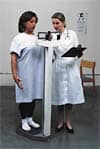The BRPT takes steps to ensure that its CRE accurately evaluates the knowledge, skills, and abilities needed for competent practice.

This year the Board of Registered Polysomnographic Technologists (BRPT) is gathering information about the jobs of polysomnographic technologists around the world. The BRPT is conducting a job analysis study to identify knowledge, skills, and abilities required for competent practice in polysomnographic technology in an effort to achieve a close-up view of the profession. As the credentialing organization for polysomnographic technologists, the BRPT conducts a job analysis every 5 years to assure the validity of its registered polysomnographic technologist (RPSGT) credentialing program.
WHY STUDY TECHNOLOGISTs’ ROLES?
The BRPT is studying the current roles and responsibilities of practicing polysomnographic technologists to ensure that its comprehensive registry examination (CRE) accurately evaluates the knowledge, skills, and abilities needed for competent practice in the field.
Designed to obtain descriptive information about the tasks performed in a job and the knowledge/skills needed to adequately perform those tasks, the job analysis will be conducted to:
- develop test specifications for the CRE for polysomnographic technologists;
- obtain useful information that can guide professional development initiatives for polysomnographic technologists; and
- ensure that the BRPT has up-to- date information about expected changes in polysomnography work over the next few years.
JOB ANALYSIS
The BRPT will conduct the job analysis in conjunction with its testing partner, Castle Worldwide Inc. Castle is renowned for its psychometric expertise and will assist the BRPT in all aspects of the job analysis, including survey development, survey dissemination, compilation of survey results, and test specifications development.
Survey research is an efficient and effective way to identify the tasks and knowledge that are important to the work performed by large numbers of polysomnographic technologists.
The survey, which is currently being developed by a group of newly credentialed and seasoned polysomnographic technologists, will ask practitioners to rate tasks using several parameters. It will cover job-related tasks most commonly performed by polysomnographic technologists and assign a level of importance based on the frequency of performance in the workplace. The survey will not only include the tasks currently covered in the CRE, but will also add new tasks that may have come into practice since BRPT conducted its last job analysis.
The survey will also collect demographic information from respondents, including geographic location, education, and level of experience. This information will help determine if the study’s results are constant across all polysomnographic technologists or if there are variations depending on demographic factors.
RESPONSES ARE CRITICAL
This year the survey will be randomly distributed in early June to 1,000 polysomnographic technologists throughout the United States, Canada, Australia, China, and Japan. Practitioners who are randomly selected to participate in the job analysis have the unique opportunity to impact the profession by providing information about the duties and tasks that are associated with their job. It is the hope of the BRPT that technologists receiving the survey will seize this opportunity and take time to respond and return the survey. For those who receive surveys, it is a chance to be involved in shaping the scope of the field for the present and future of the profession.
Once the survey is distributed and returned from a select group of respondents, the data will be analyzed by Castle Worldwide to assist the BRPT’s examination development committee in determining the framework of the CRE by identifying content areas and the appropriate number of questions needed in each area. Examination questions may be retired if they do not reflect the results of the survey, and the resulting “item bank” or a list of questions will be inventoried to determine if new questions need to be developed to maintain the updated content outline.
CONTENT AND REQUIREMENTS
The current version of BRPT’s examination, the CRE, was developed based on the results of a job analysis conducted in 2000. The results of the study revealed five main areas of practice for polysomnographic technologists, including:
- gathering and analyzing patient information;
- performing testing preparation procedures;
- performing polysomnographic procedures;
- performing polysomnographic record scoring; and
- engaging in service management and professional issues.
The CRE is currently administered twice a year at 22 test sites for each administration. Prior to taking the examination, applicants must demonstrate completion of eligibility criteria including a length of paid clinical experience, certification in basic cardiac life support or its equivalent, and a commitment to uphold the BRPT Standards of Conduct.
THE FUTURE OF POLYSOMNOGRAPHY
The BRPT’s 2004 job analysis is designed to keep in step with the current state of our profession and anticipate the future direction of the field.
From all indications, standards and credentials are growing in recognition and importance within polysomnography; 73% of polysomnographic technologists surveyed in a 2003 Association of Polysomnographic Technologists study reported having earned the RPSGT credential. The survey indicated that RPSGTs typically earn $200 more over a 2-week period than those without the credential. Currently, there are more than 6,000 RPSGTs across the globe.
Any updates or alterations to the BRPT eligibility criteria for the RPSGT credential or CRE content outline will go into effect in 2005. Eligibility criteria and a content outline for the updated CRE will be published in the 2005 BRPT Candidate Handbook. To stay updated on the progress of the BRPT’s job analysis study throughout the year, technologists can visit www.brpt.org to sign up to receive the organization’s new newsletter, the BRPT Insider.
Mark DiPhillipo, RPSGT, is president of the Board of Registered Polysomnographic Technologists and assistant director at the Center for Sleep Medicine, Lafayette Hill, Pa.



